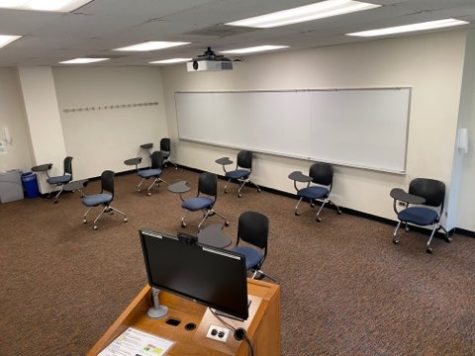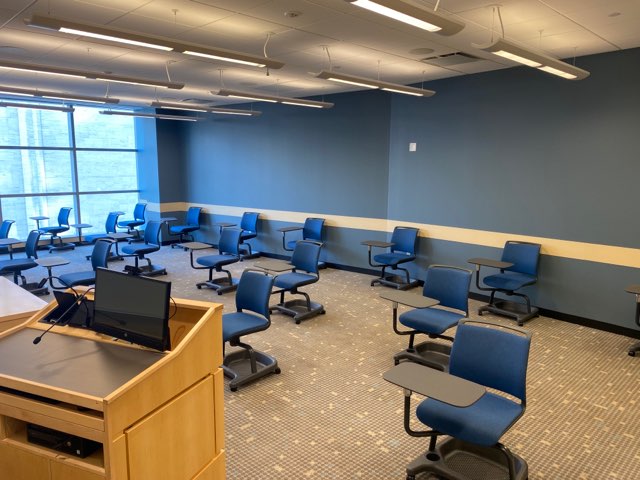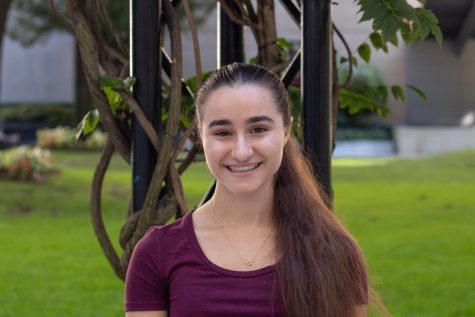Concerned and Optimistic: Students Prepare for an Unprecedented Semester
COURTESY OF FORDHAM
Lincoln Center will get a new look this semester with students having the option of taking classes either online or in person. Social distancing measures will be enforced in classrooms, elevators and common areas.
July 30, 2020
With less than a month to go before the academic year begins, the Office of the President released an update on July 20 further detailing the university’s plans for resuming operations in the fall semester. Included in the plan is the decision to not continue in-person classes after Thanksgiving break and specifications on de-densifying the campus.
This is the first update since Fordham’s previous announcement on June 30, which contained a 35-page document detailing the university’s phased approach to bringing students back to campus.
Since the last report from the university, New York City entered into Phase Four of reopening, which solidifies New York colleges and universities’ ability to be in operation at full capacity. However, despite permission from the state to have personnel on campus, the small footprint of the Lincoln Center campus makes proper social distancing tactics difficult to organize.
As a result, Fordham plans to have some faculty and students teach and learn remotely, as well as to reduce volume in the residence halls and common spaces.
“Our campus is not built for social distancing — much less Manhattan,” Sydney Costales, Fordham College Lincoln Center (FCLC) ’21, said. Costales, who is returning from quarantine in Hawaii, is preparing to move off campus to Brooklyn come the fall and take all online classes.
She said her decision not to return to campus comes from feeling unsafe considering that students will be traveling from all parts of the world to New York City.
“We know (New York City) has been hit really hard in the past, and they are doing really good right now, but I’m sure we’re all aware how quickly that can change,” she said.
In order to make the living space at Lincoln Center more adaptable to social distancing procedures, the university plans to create one-way corridors, install protective barriers at all high-traffic areas, designate entrances and exit doors for each building, and convert non-traditional classroom spaces into classrooms to limit occupancy in classes.
One of the main drawbacks to the Lincoln Center campus, which several students have referenced as a point of concern with university social distancing practices, is the tightly packed nature of the elevators in the Lowenstein Center.
On Fordham’s website for updates on the coronavirus, “lessening elevator capacities” is listed as an objective point for preparing for the fall. No further elaboration is provided on how the task force plans to achieve this; however, the website does additionally state plans to increase time in between classes to hopefully stagger students heading to and leaving from class.
In addition to lessening the number of people in any particular area of the campus, the university also plans to install filtration and dilution systems which will be in operation 24 hours a day. These mechanisms aim to purify air inside the buildings on campus to minimize exposure to the virus.
The university outlined a detailed plan for monitoring the virus’s effect on campus, including mandatory universal coronavirus (COVID-19) testing for all faculty, students and staff prior to arrival on campus, and then again at set intervals throughout the semester.
Throughout the semester, Fordham students, faculty, staff, administrators or guests will be required to respond to a series of pre-screening questions through the application VitalCheck before entering campus. The university member or guest must receive clearance in order to enter campus grounds.
There is also a system for contract tracing and quarantine procedures in case a student on campus does become infected with COVID-19. Residence hall rooms will be designated for individuals to quarantine if they become infected, as well as spaces off-campus, if needed.
Some students have expressed that these precautionary measures are enough to feel comfortable returning to campus.
“For many students, including myself, who flourish under face-to-face instruction, reopening will allow us to take full advantage of the opportunities that Fordham offers,” Aisha Virender Sanwal, Gabelli School of Business Lincoln Center (GSBLC) and FCLC ’23, said.
Virender Sanwal is double-majoring in global finance and political science, and she feels that living in the dorms and taking in-person classes are the best way for her to receive an education. She said that the daily screening and testing procedures that Fordham plans to enact reassures her that the pandemic’s spread on campus will be carefully monitored.
Currently, there is a mandated self-quarantine for 14 days for people coming to the New York metro area from any of the 31 states that are experiencing severe outbreaks of COVID-19. The large quantity of residents quarantining on campus at the start of the academic year could pose a threat to the envisioned purpose of these spaces.


On July 27, the university released its plan for students who wish to return to the campus from one of the restricted states. “All students coming from restricted states and other countries should plan adequate time both to quarantine and to get tested,” the email from Jeffrey Gray, senior vice president for student affairs, stated.
Students coming from restricted states are expected to quarantine for 14 days in a location not on the list of restricted states and take a COVID-19 test within a 7-day period prior to coming to campus. The university said that it is waiting on approval from New York state to allow students coming from a restricted state and planning to live in Fordham housing to quarantine in their respective residence hall room or on-campus sites. Before official guidance from the state however, the university recommends students make off-site plans for quarantining, such as hotels or areas outside one of the restricted states.
Another option is for the student to remain at home and take classes online until the restriction on their state is removed.
Since the pandemic is still an evolving situation, with new research coming out daily about the way the virus behaves, students find themselves questioning how “campus life” will be impacted when they return.
“I honestly don’t think that we’re going to be able to have a lot of campus activity next fall,” Costales said. “I just don’t see logistically how that would play out in terms of social distancing.”
The university, as of yet, has not provided much information on how extracurricular activities may or may not, be impacted by regulations on campus.
When students return to campus they will be required to accept the following actions, referred to as “The Ram Pledge”: always wear a mask in public places on and off campus, wash hands frequently and for at least 20 seconds, self-monitor for COVID-19 symptoms and complete VitalCheck screenings daily, follow all university protocols to measure the virus’s spread, and “act in the spirit of people for others.”
These actions delineated in the pledge provide some insight into how campus life may be affected. Additionally, student visitation passes for the fall semester for all non-Fordham students will be suspended.
Other concerns students have about their return to campus is the event of another campus shutdown. Fordham’s tuition rate increased by 3.33% this year, stirring tensions among students who are already experiencing financial hardship from the shutdown of many businesses due to the pandemic.
“I’m worried that, in case one of my three roommates can no longer room, the others and I will have to assume those expenses,” Virender Sanwal said. “This would be an added concern on top of the additional 3.33% increase in tuition rates Fordham announced last month.”
Adding to her concerns is contention involving reimbursement rates. For the spring semester of 2020, when students were sent home early due to the COVID-19 outbreak in New York, there was a 50% refund for housing, meal plans and selected fees. However, the partial refund wasn’t deemed acceptable by many students who felt that their education had been impacted by the transition to online and wished for their tuition to have been reimbursed as well.
Going into the next semester, when another campus shutdown is a possibility, those tensions persist. “Understandably, educational institutions need this money to offset costs, but students should also not suffer financially when the situation is in no fault of their own,” Virender Sanwal said.
The incorporation of the hybrid class model that Fordham plans to utilize is supposed to help the transition into a fully online class method in the event of an early shutdown. Currently, the university is working under the expectation that after Thanksgiving break, all students will be transitioned into fully online classes.
Beginning July 27, students will have the opportunity to declare their preference of either fully online, hybrid or fully in-person classes for the fall 2020 semester, according to Laura Auricchio, dean of Fordham College at Lincoln Center.
While many Fordham students have yet to make a decision about returning in the fall, the ones who have expect many things to be different, regardless of their choice.
“Overall, it will be quite a different scene back on campus this fall, but I hope for the best,” Virender Sanwal said. “After all, optimism is key to overcoming adversity.”













